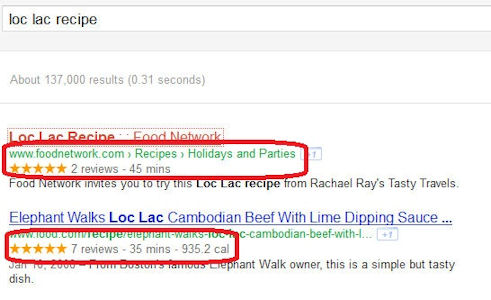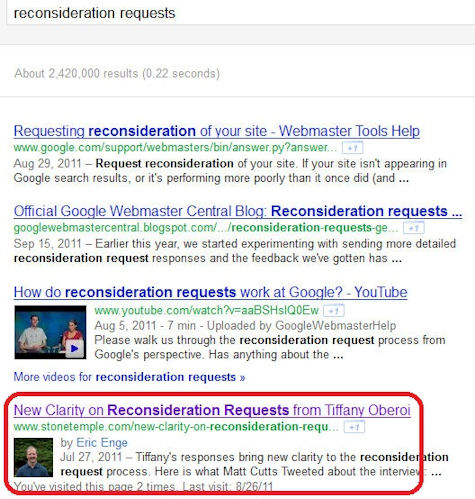How To Use Rich Snippets, Structured Markup For High Powered SEO
The click-through rate benefits are enough to make markup in your content, particularly in those cases where it is already known to be supported, a worthwhile effort.
I recently received a question from a reader asking about the way search engines were using microformats and other forms of structured markup.
Today, I am going to address that topic from the perspective of its impact on SEO. What is particularly interesting about this topic is that structured markup provides publishers a way to provide the search engines information about their website(s).
One of the original ways of doing that was with metatags. Unfortunately, these were so badly abused by spammers that Google stopped using it as a ranking signal. Google finally stated this publicly in this post in 2009, which notes that “Google has ignored the keywords meta tag for years and currently we see no need to change that policy.”
Google continues to indicate that markup is not used as a ranking signal: “Google doesn’t use markup for ranking purposes at this time.” However, there are important SEO benefits to using markup, and I will explore these in today’s column.
Markup In Search Results
The first benefit is that you can impact the appearance of your search listings, creating what we call a “rich snippet.” Here is an example of rich snippets in the search results, as shown on a search for one of my favorite recipes, loc lac:
The presence of the stars in the search listing will tend to draw the human eye and increase the click-through rate for those results. These modified listings are a result of the use of markup in the source code for the webpages.
The next two screen shots will give you a view as to what the code is for the first of the two search results. The first screen shot shows a piece of the hrecipe format (which is a type of Microformat) that includes the code for specifying the breadcrumb links:
Looking farther down in the hrecipe format, we get a look at the code which shows an implementation of a review (in the hreview-aggregate tag) and also shows the cook time for the recipe:
You will see additional elements included in the markup as well. My purpose in showing you this is not to try to teach you the coding details, but to illustrate the connection between the use of publisher tagged data and an impact on the search results.
There are many more examples of rich snippets and a discussion of different types of markup here. You can see information on microdata, microformats and RDFa, as well as the types of categories supported by Google. Some of the more common types of markup are:
In June, Google announced support for the “rel=author”, which is another form of markup. This adds the author’s picture in the search results next to search listings for the articles they have written.
Implementing this is not simple, but you can read an excellent article on how to implement rel=author here. Here is an example of what this looks like in the search results:
It’s About Click-Through Rates
One thing I have learned (over and over again!) in my time as an Internet marketer is that a morass of boring text is … well, boring. The eye is drawn to search listings that look different.
Images, such as result from rel=author, or the asterisks in the recipes (you can also get pictures in your recipes as well) do wonders, but any level of difference that breaks up the 10 blue links will do great things for you.
As a result, your click-through rate will go up, and this will bring you more qualified visitors, and that is, after all, what SEO is all about.
In addition, if you believe (as I do) that click-through rate and search results interaction is a ranking factor (you can see what Bing’s Duane Forrester had to say about Click-Through Rates and Search Rankings here), then this starts to sound like a double win.
You get higher CTR without changing your ranking; and provided that the user does not simply bounce back to the search results and click another listing, you get higher rankings to boot.
How do I reconcile this belief with Google’s statement that they don’t use markup as a ranking factor? Actually, there is no conflict there. I believe that they use CTR as a ranking factor, not the markup itself.
Remember, Google is often quite literal in the way they express things. The influence in rankings is indirect, so their statement would still be true.
Enter Schema.org
On June 2, Bing, Google and Yahoo announced the launch of Schema.org. This is markup based on the microdata specification. Google indicates that the reason the companies chose microdata over other types of markup such as microformats and RDFa is:
Instead of having webmasters decide between competing formats, we’ve decided to focus on just one format for Schema.org. In addition, a single format will improve consistency across search engines relying on the data. There are arguments to be made for preferring any of the existing standards, but we’ve found that microdata strikes a balance between the extensibility of RDFa and the simplicity of microformats, so this is the format that we’ve gone with.
I don’t think that the search engines will end their support for the other formats any time soon, but the weight of their attention will shift to Schema.org (microdata), and as a publisher your attention should shift in that direction too. As they add support for new rich snippets, that will most certainly focus on the microdata approach since they can all count on each other to support the same format.
Summary
I am bullish on adding support for Schema.org markup in your content, particularly in those cases where it is already known to be supported. The click-through rate benefits are enough to make this effort worthwhile.
If you have content that fits a format that is not yet supported by rich snippets, you may want to wait and invest your development effort elsewhere, but I would move quickly once support is announced.
I am excited that Google, Bing and Yahoo are all involved in Schema.org. When the search engines band together to define a standard, it is a major sign that something is here to stay, and that it is important. This makes it a more interesting area for us as publishers to invest effort into.
Contributing authors are invited to create content for Search Engine Land and are chosen for their expertise and contribution to the search community. Our contributors work under the oversight of the editorial staff and contributions are checked for quality and relevance to our readers. The opinions they express are their own.
Related stories
New on Search Engine Land



